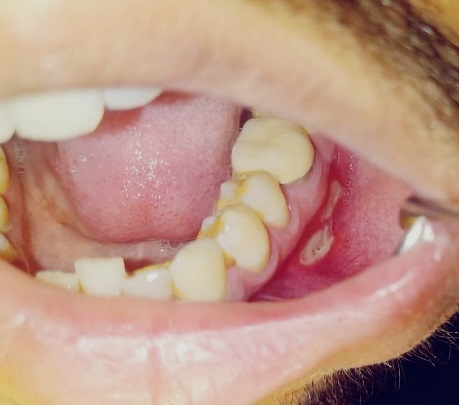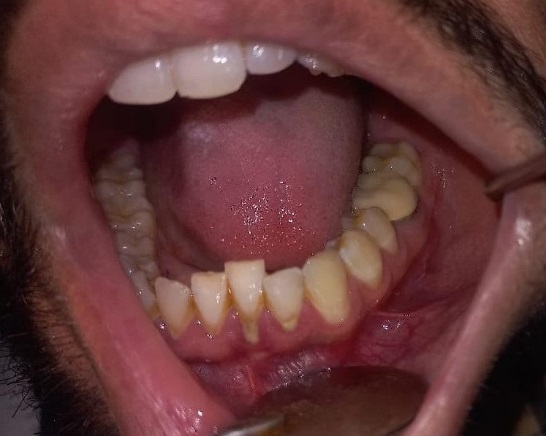Introduction
Aphthous ulcers are one of the most common oral lesions, affecting 5-25% of the general population, with a recurrence rate as high as 50% within three months.1 Aphthous ulcers are commonly painful, can cause swallowing difficulties, and may have a negative impact on the patient's quality of life.2
The precise cause of recurrent aphthous stomatitis (RAS) remains unclear, but genetic predisposition and immune mechanisms are thought to play a role in most cases. TNF-α, produced by T cells, mast cells, and macrophages initiates mucosal inflammation by facilitating the endothelial cell adhesion and neutrophilic chemotaxis, thus, highlighting the role of cell-mediated immunity in the immunopathogenesis of RAS.3 Several triggering factors, including trauma, hormonal imbalances, nutritional deficiencies, psychological stress, food hypersensitivity, and the cessation of smoking, may also play a role.4
RAS is marked by multiple, recurrent small ulcers that are round or oval, with well-defined edges, erythematous halos, and yellow-gray centers, typically appearing first in childhood or adolescence.5 Stanley (1972) classified RAS into three types: minor, major, and herpetiform ulcers.6 The classification is based on criteria such as the size and depth of the lesions, the number of lesions per episode, their location, and their duration.7
While most aphthous ulcers are small and typically heal within 7-10 days, larger ulcers may last for weeks or even months. Thus, treatment for recurrent aphthous ulcers should aim to both facilitate healing and prevent the development of new ulcers.8
At present, there is no standardized treatment protocol for RAS, so management primarily aims to alleviate pain, decrease inflammation, and promote wound healing. Topical steroids are generally used as the first-line treatment, but extended use can lead to a range of side effects.9, 10
Topical use of 5% Amlexanox oral paste and the systemic administration of Rebamipide tablets is the emerging treatment approach for RAS, and studies have shown that 5% Amlexanox oral paste and Rebamipide tablets are crucial components in the pharmacological management of RAS.11, 12, 13
This paper discusses a case of major aphthous stomatitis in a 23-year-old male patient and its management with 5% Amlexanox paste and Rebamipide tablets.
Case Report
A 23-year-old male patient was referred to our Outpatient Department to assess oral ulcers that had been persistent and non-healing for the last 1.5 months. History revealed multiple episodes of oral ulcers over the past 8 months, with an increased frequency in the last 2 months. The ulcers initially started as smaller lesions and then coalesced to reach their current size. His medical and family history were unremarkable, and the patient reported not taking any systemic medications.
The patient had consulted several private practitioners and received various medications, but none of the prescribed treatments led to improvement of the ulcers.
The general physical examination was unremarkable, showing no signs of systemic or nodal involvement. Intra-oral examination revealed two large elliptical ulcers on the left vestibule adjacent to the mandibular posterior teeth. The ulcers, approximately 1.2 cm x 1 cm in size, were bordered by erythema and covered with a yellowish pseudomembranous slough. Upon palpation, severe tenderness (VAS score of 8) and induration were observed [Figure 1]. The patient was in extreme discomfort, and the ulcers interfered with speech and swallowing. Based on the history and clinical features, the diagnosis of major aphthous stomatitis was made. The differential diagnosis included traumatic ulcers, herpetic ulcers, tuberculous ulcers, and bullous autoimmune disorders.
The patient reported that hematological, biochemical, and radiographic tests had been performed a week ago, as advised by the private practitioner. Hematologic tests, including a complete blood count, serum iron levels, ferritin, C-reactive protein (CRP), and erythrocyte sedimentation rate (ESR), were all within the normal range. The Mantoux test was non-reactive, and the chest radiograph (PA view) displayed normal lung fields and bilateral bronchovascular markings. The colonoscopy reports were normal and did not reveal any signs of inflammatory bowel disease.
The patient was prescribed 5% Amlexanox oral paste (Lexenox oral paste) to be applied topically three times daily, along with Rebamipide (Rebagen) 100 mg tablets three times daily for 7 days. Following the treatment, the patient experienced complete resolution of the ulcers [Figure 2]. During a 6-month follow-up, there were no recurrence of the lesions.
Table 1
Discussion
Recurrent aphthous stomatitis (RAS), also referred to as recurrent aphthous ulcers or canker sores, is categorized as a chronic inflammatory disorder of the oral mucosa. 14
The precise etiopathogenesis of RAS is not yet fully understood, although, immunological abnormalities including neutrophil reactivation and hyper-reactivity, elevated levels of complement proteins and cytokines, increased numbers of natural killer (NK) cells and B-lymphocytes, and a disrupted CD4/CD8 ratio play a major role. 2
Potential trigger factors include genetic predisposition, bacterial and viral infections, hormonal imbalances, food allergies, nutritional deficiencies, increased oxidative stress, mechanical trauma, psychologic ailments, and systemic disorders (such as cyclic neutropenia, Crohn’s disease, inflammatory bowel disease, and AIDS). 7, 11, 14
The most salient feature of the disease is the recurrent onset of single or multiple painful ulcers, typically bordered by an erythematous halo and covered with a fibrous coating. These ulcers primarily affect the non-keratinized mucosa of the lips, cheeks, and tongue, although they may occasionally occur on the keratinized mucosa of the palate and gums. 5, 15 Most patients experience a pricking or burning sensation in the affected area for a day or two before the ulcer appears. 16
Based on the history and clinical features, recurrent aphthae can be classified into three main types: minor aphthae (Mikulicz’s aphthae or MiRAS), major aphthae (Sutton’s aphthae or MaRAS), and herpetiform aphthae (HeRAS). 6, 8, 10 The distinguish features between the three types are summarized in Table 1. 8, 10, 17
Recurrent aphthous stomatitis is diagnosed clinically. 18 However, it's crucial to exclude other possible causes of recurrent mouth ulcers, such as Behçet disease, nutritional deficiencies, or inflammatory bowel disease, particularly if RAS appears suddenly in an adult patient. 14 Patients with RAS may show signs of anemia or deficiencies in hematinic factors or diet. Therefore, it is important to assess the complete blood count, red cell folate, ferritin, and vitamin B12 serum levels, as these tests can help identify underlying gastrointestinal disorders. 18
Herpetic ulcers, traumatic ulcers, malignant ulcers, oral tuberculous ulcers, syphilitic ulcers, and RAS-like ulcers are given a place in the differential diagnosis of aphthous ulcers. 19 Natah et al. 7 proposed the diagnostic criteria for minor RAS.
RAS treatment varies widely and lacks a definitive guideline. Management primarily aims to provide symptomatic relief, shorten the healing period, and reduce the frequency of recurrences. 2, 9, 10, 16
Different treatment protocols have been developed for RAS, spanning a broad spectrum of options from topical to systemic therapies. Systemic treatments are recommended for chronic and severe cases, whereas topical therapies are usually preferred for minor forms of RAS . 8, 11, 20 However, the emerging treatment regimen for RAS now involves the topical application of 5% Amlexanox oral paste and the systemic use of Rebamipide tablets. Currently, 5% Amlexanox oral paste is the only RAS treatment that has been approved by the U.S. Food and Drug Administration (FDA). 20
The potent anti-inflammatory, anti-allergic, and immunomodulatory effects of 5% oral amlexanox paste validates its use in RAS patients. It works by inhibiting the formation and release of inflammatory modulators with a membrane-stabilizing effect on cellular structures. It increases intracellular cyclic adenosine monophosphate (cAMP) content, thus, inhibiting the release of inflammatory mediators (histamine, tumor necrosis factor-alpha, and leukotrienes). Moreover, adverse effects are rare, and include mild and transient tingling sensations, a metallic taste, xerostomia, and bleeding at the application site. 11, 21, 22
5% amlexanox is the most effective treatment for minor RAS, offering a threefold benefit in preventing recurrence, alleviating pain, and accelerating healing. Statistically significant results are achieved when it is applied four times a day, starting from the prodromal phase and continuing until complete healing. 7, 23
Amlexanox oral paste is formulated to improve mucosal adherence, thereby minimizing the drug risk being displaced or washed away by saliva, as per the manufacturer's instructions (Macleods Pharmaceuticals, Mumbai, India). 24
Rebamipide, a quinolinone derivative originally developed for gastric ulcers, has garnered interest due to its mucosal protective properties. 25 Patients with Behcet’s disease also reported a reduction in both the frequency and pain of ulcers following rebamipide therapy. 13 Published litaerature have shown that rebamipide is effective in the treatment of Behcet’s disease and recurrent aphthous stomatitis (RAS), 11, 13, 26 supporting its use as a long-term treatment for recurrent oral ulcers. 17
Rebamipide, a mucoprotective agent, preserves the epithelial cell health and promote the repair of damaged tissue through various mechanisms. 6, 11, 12 It enhances the preservation of existing epithelial cells by increasing the content of soluble mucus, increasing the gastric concentrations of PGE2 and PGI2, down regulation of 15- hydroxyprostaglandin dehydrogenase, increasing mucosal blood flow through enhanced nitric oxide synthase activity, decreasing the expression of neutrophil adhesion molecules (CD11b/CD18), inhibiting the secretion of TNF; α by inhibiting the synthesis of inflammatory E; selectin and has a free radical scavenging effect on reactive oxygen species. It also facilitates tissue repair by boosting the expression of epidermal growth factor and its receptors, thus, resulting in angiogenesis, increased granulation tissue production, and the epithelialization of ulcer healing. 10, 26
Conclusion
Due to an obscure etiology, most of the RAS treatment is therapeutic. 5% Amlexanox paste and rebamipide are both effective treatments for aphthous ulcers, each offering distinct benefits. Amlexanox, with its potent anti-inflammatory, anti-allergic, and immunomodulatory properties, significantly reduces recurrence, pain, and healing time when applied topically. On the other hand, rebamipide demonstrates notable mucosal protective properties by preserving epithelial cell vitality and promoting tissue repair. Both therapies provide valuable options for managing recurrent aphthous ulcers, with amlexanox offering rapid relief and rebamipide supporting long-term mucosal health and repair.


